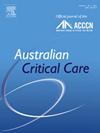Opioid administration and weaning practices in mechanically ventilated adult intensive care unit patients: A retrospective analysis
IF 2.7
3区 医学
Q2 CRITICAL CARE MEDICINE
引用次数: 0
Abstract
Background
Opioids are commonly administered via continuous infusion in the intensive care unit (ICU) to manage pain and anxiety during mechanical ventilation, yet strategies for safe and effective weaning remain inconsistent. This study aimed to identify clinical and opioid-related factors associated with failed weaning and prolonged opioid cessation.
Objective
The purpose of this study was to examine opioid administration and weaning practices in mechanically ventilated adults, specifically analysing associations between opioid exposure, infusion duration, percentage reduction in dose, and failed weaning attempts to identify key factors influencing weaning outcomes.
Methods
A retrospective cohort study was conducted in a metropolitan general ICU in Australia. Adult patients receiving continuous opioids and mechanical ventilation for ≥24 h were included. Demographic and clinical data were extracted from medical records and the Australian and New Zealand Intensive Care Society Adult Patient Database. The primary outcome was the association between patient and opioid infusion factors with failed weaning events, defined as a ≥10% reduction from the average hourly opioid rate in the 4 h before weaning. Multivariate logistic regression, Cox proportional hazards models, and linear regression were employed.
Results
Among the 240 patients, 75.8% experienced at least one failed opioid weaning attempt. Higher cumulative opioid exposure and prolonged infusion duration were significantly associated with weaning failure (χ2 = 27.41, degrees of freedom [df] = 1, p < 0.001). A greater percentage reduction in opioid dose was also a significant predictor of failure (odds ratio: 1.0224, 95% confidence interval: 1.010–1.036, Wald χ2 = 11.81, p = 0.0006). Median dose reductions during weaning ranged from 22.6%–39.3% across opioid types. No significant correlation was observed between opioid infusion rates and pain scores (β = −0.00248, t = −1.85, p = 0.065).
Conclusions
Failed opioid weaning was common, and high percentage reductions in continuous opioid infusion were linked to weaning failure. Findings suggest the need for structured, gradual opioid tapering strategies and standardised weaning protocols in adult ICUs.
机械通气成人重症监护病房患者阿片类药物管理和脱机实践:回顾性分析
背景:在重症监护病房(ICU),通常通过持续输注给药来控制机械通气期间的疼痛和焦虑,但安全有效的脱机策略仍不一致。本研究旨在确定与断奶失败和阿片类药物长期停止相关的临床和阿片类药物相关因素。目的本研究的目的是检查机械通气成人的阿片类药物给药和脱机实践,特别是分析阿片类药物暴露、输注时间、剂量减少百分比和脱机失败尝试之间的关系,以确定影响脱机结果的关键因素。方法在澳大利亚某大城市普通ICU进行回顾性队列研究。纳入持续接受阿片类药物和机械通气≥24 h的成年患者。人口统计和临床数据提取自医疗记录和澳大利亚和新西兰重症监护协会成人患者数据库。主要结局是患者和阿片类药物输注因素与脱机失败事件之间的关系,定义为脱机前4小时平均每小时阿片类药物发生率降低≥10%。采用多元逻辑回归、Cox比例风险模型和线性回归。结果240例患者中,75.8%的患者至少经历过一次阿片类药物脱机失败。较高的阿片类药物累积暴露量和较长的输注时间与断奶失败显著相关(χ2 = 27.41,自由度[df] = 1, p <;0.001)。阿片类药物剂量的较大百分比减少也是失败的显著预测因子(优势比:1.0224,95%可信区间:1.010-1.036,Wald χ2 = 11.81, p = 0.0006)。断奶期间阿片类药物的中位剂量减少范围为22.6%-39.3%。阿片类药物输注率与疼痛评分无显著相关性(β = - 0.00248, t = - 1.85, p = 0.065)。结论阿片类药物脱机失败是常见的,持续阿片类药物输注的高比例减少与脱机失败有关。研究结果表明,成人重症监护病房需要结构化的、渐进的阿片类药物减量策略和标准化的断奶方案。
本文章由计算机程序翻译,如有差异,请以英文原文为准。
求助全文
约1分钟内获得全文
求助全文
来源期刊

Australian Critical Care
NURSING-NURSING
CiteScore
4.90
自引率
9.10%
发文量
148
审稿时长
>12 weeks
期刊介绍:
Australian Critical Care is the official journal of the Australian College of Critical Care Nurses (ACCCN). It is a bi-monthly peer-reviewed journal, providing clinically relevant research, reviews and articles of interest to the critical care community. Australian Critical Care publishes peer-reviewed scholarly papers that report research findings, research-based reviews, discussion papers and commentaries which are of interest to an international readership of critical care practitioners, educators, administrators and researchers. Interprofessional articles are welcomed.
 求助内容:
求助内容: 应助结果提醒方式:
应助结果提醒方式:


